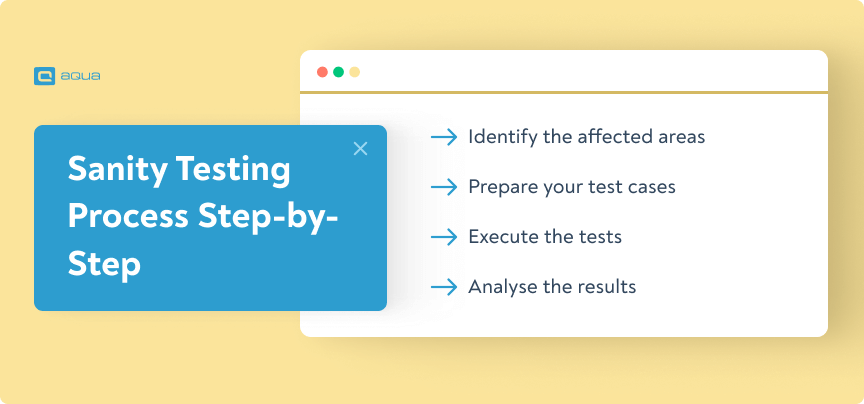Key Takeaways
- Sanity testing is a focused check of specific application areas after minor changes or bug fixes to ensure core functionalities still work properly.
- Unlike comprehensive regression testing, sanity testing saves time by targeting only the components potentially affected by recent updates.
- Sanity testing differs from smoke testing as smoke testing checks if a new build works at all, while sanity testing verifies that specific fixes didn’t break critical features.
- The sanity testing process includes identifying impacted areas, preparing targeted test cases, executing focused tests, and analyzing results to determine if further testing is needed.
- Sanity testing can be performed manually for one-off fixes or automated for frequent updates, with each approach having distinct advantages for different scenarios.
Wondering if your small code change might secretly break your entire application? Sanity testing helps you catch these issues before they escalate, but it’s just one piece of the quality assurance puzzle. Discover the complete testing strategy you need 👇
What is Sanity Testing?
Sanity testing is a quick check to ensure that key parts of your application still function correctly after minor changes or bug fixes. It’s a type of software testing focused on validating core functionalities, ensuring that recent updates haven’t introduced new issues. Unlike full regression testing, which covers the entire system, sanity testing is more targeted and faster.
Sanity testing and smoke testing are often confused, but:
- Smoke testing checks if the basic features of a new build are working at all,
- Sanity testing comes later, verifying that the specific fixes or updates didn’t break anything critical.
Now that you see what sanity testing is and how it differs from the smoke testing definition, let’s move on to why you need it.
In my mind Sanity tests would be "Let's make sure we didn't break anything horribly, just in case".
Purpose of Sanity Testing
So, why do you need sanity testing?
When you make small updates, it’s easy to assume everything will run smoothly—but that’s not always the case. Sanity testing ensures you’re not blindsided by new issues after a fix or tweak. It’s a quick way to:
- Validate critical areas that may be impacted by changes.
- Catch new bugs before they disrupt your project.
- Save time by focusing only on relevant parts, instead of a full regression.
- Get quick feedback so you can confidently move forward.
So sanity testing keeps your software testing process sharp, helping you prioritise quality without wasting resources. It is especially crucial in fast environments and within tight deadlines where you need to leverage every second.
Sanity Testing Process
Now that you understand the why of the sanity testing process, let’s break down the how. Sanity testing is quick and targeted, but it still follows a structured approach to make sure nothing is missed. Think of it as a focused inspection of the most critical areas that could be impacted by recent changes.
Here’s a step-by-step guide to the sanity testing process:
- Identify the areas impacted by recent changes
Start by reviewing the specific updates or bug fixes. You want to narrow your focus to just the areas that could have been affected by the changes. For example, if you’ve modified the user profile feature, concentrate your sanity tests on that module. This saves time and ensures you’re testing only what matters. - Prepare your test cases
Choose targeted test cases that focus on the core functionalities of the impacted areas. These test cases should be simple but effective. For example, if you updated the login feature, your test cases should check basic login functionality (e.g., entering valid credentials, and password resets). Think of it as performing a quality spot-check. - Execute the tests
Run your tests on the specific areas you’ve identified. Since sanity testing process is all about efficiency, you don’t need to run a full regression suite. Focus only on the changes and how they affect the core functionality. If you’ve recently updated the search feature, test that users can still perform searches without errors. - Analyse the results
After running your tests, review the results. If everything works smoothly, you’re ready to move forward. But if any new issues appear, this could signal deeper problems, as it prompts the need for further regression testing.

This is the short theoretical checklist for sanity testing, similar to all the other software testing types. However, the practical steps are a little bit different. Let’s break them down shortly.
Now that you understand the theory behind sanity testing, it’s time to put your knowledge to the test. Can you identify which test cases are truly essential for sanity testing versus those that should wait for full regression testing? Try our interactive challenge below to see how well you can balance speed with thoroughness, just like a QA engineer facing tight deadlines.
Test Case Precision Challenge
▼How to Perform Sanity Testing?
As you already know, performing sanity testing is all about efficiency. The goal is to validate recent changes quickly while focusing on the most critical parts of your application. Here’s how you can ensure sanity testing is done right from the technical perspective:
- Start with small, focused test cases
Select test cases that focus specifically on the updated areas. This means no unnecessary testing of unrelated modules. For example, if the update fixed a bug in the payment gateway, just test the payment flow. Keeping your scope small ensures faster results while focusing on what matters most. - Run sanity tests manually or automate them
You can run sanity tests manually or use automation, depending on your project’s needs. For simple fixes, manual testing might be quicker. But for recurring tests or more complex features, automated sanity tests can help you get faster, more reliable results. And of course, automation tools allow you to run these tests consistently as they free up time for more in-depth testing. - Prioritise critical paths
Focus on the essential parts of your application—these are the areas that, if broken, would cause the biggest disruptions. For example, if your update involves fixing a checkout issue, test the entire checkout process (add items to the cart, apply a discount, process payment) to ensure it works seamlessly. - Document your findings
Keep a record of the sanity tests you run, along with their results. Even if everything passes, having this documentation allows you to track what was tested and helps in troubleshooting if any future issues arise. If you’re using a documentation tool, the process becomes much easier as it stores and tracks all your testing activities. - Determine next steps
If your sanity tests pass, it’s a green light to move forward with the development cycle. But if new issues surface, it’s time to dive deeper with more extensive regression testing. Sanity testing is a quick checkpoint, helping you decide whether to proceed or investigate further.
By focusing on these steps, you can perform sanity testing efficiently and ensure the application remains stable after every change. It’s about working smart, not hard—letting you spot issues before they escalate into bigger problems.
Now that you’ve seen how critical sanity testing is for keeping your application stable after updates, imagine having a tool that simplifies this process and takes your testing efforts to the next level. A Test Management System (TMS) can centralise and automate every step, making it easier to track, document, and manage your sanity tests efficiently. But what if you could go beyond just sanity testing?
That’s where aqua cloud comes in. aqua goes above and beyond managing basic sanity tests. Its AI-powered test case generation saves you 97% of the time while delivering 100% coverage for even the most complex testing scenarios. With aqua, you’ll get real-time insights, complete traceability from requirements to defects, and powerful integrations with automation and project management tools like Jira, Jenkins, UnixShell, PowerShell, and Azure DevOps. Plus, with Capture integration, you can instantly record and report bugs with just one click. Ready to transform your testing efforts into a breeze?
Do not only streamline sanity testing; simplify and automate 200% of your testing efforts
Sanity Testing Examples
Now that we know how sanity testing works and why it’s crucial, let’s dive into some real-world examples to see how it’s applied in both manual and automated testing scenarios.
Manual Sanity Testing
Manual sanity testing is when you execute targeted tests yourself, without using automated tools. This approach is especially useful when dealing with one-off fixes or changes in less complex areas of the system.
For example, after fixing a login issue, you might start by testing valid and invalid credentials to ensure the login feature works. Once logged in, you would check that the user dashboard loads properly. Next, you’d go through the checkout process to verify transactions still function as expected. This way, you confirm that the login fix hasn’t broken other key areas of the app. Each step ensures core functionality remains intact.
As you see, manual sanity testing heavily relies on critical thinking, as you can identify unexpected behaviour while interacting with the system. It can be time-consuming, especially for larger projects, but it’s also flexible and ideal for changes that don’t require frequent repetition. Also, when the test cases are too specific for automation, manual sanity testing is the way to go.
Automated Sanity Testing
Automated sanity testing is about running predefined test scripts using tools. This is particularly helpful when your application undergoes frequent minor updates. Automation tools allow you to run sanity tests repeatedly and quickly after each update.
Let’s say a bug fix in the login process affects other parts of your app, like the checkout and account settings. Instead of manually testing each section, automated sanity testing allows you to run all these checks with a single script. The script would:
- Start by validating the login
- Move on to confirm that the user can successfully reach the checkout
- Ensure that the account settings are functioning correctly.
This maintains all the impacted areas verified without requiring manual testing for each feature. As a result, you are saving time while ensuring nothing critical breaks.
The main benefit of automated sanity testing is speed and consistency. You can test multiple functionalities in minutes instead of hours. However, it requires an initial setup and maintenance of scripts, so it’s more beneficial for recurring or larger-scale projects.
Pros of Sanity Testing
There are several benefits of using sanity testing in your testing efforts, including the following:
- Saves time: It narrows down the scope of testing, focusing only on impacted areas after minor changes.
- Prevents regression testing overload: You don’t need to retest the entire system, only the relevant parts.
- Quick feedback: You can immediately verify that your critical functionality is still intact without waiting for full regression testing results.
- Efficient for small teams: If your QA resources are limited, sanity testing allows for fast, targeted validation without stretching your team too thin.
- Reduces risk: It helps catch new defects before they make it to production, minimising the chances of releasing broken features.
Cons of Sanity Testing
However, sanity testing also comes with its cons, including the ones below:
- Limited coverage: Since it’s focused only on specific areas, sanity testing might miss issues in other parts of the system.
- Requires accurate scoping: You need to know exactly which parts of the system are impacted by the changes—otherwise, crucial areas might not be tested.
- Can be redundant: For smaller updates, manual sanity testing might feel like an unnecessary step if the update is too minor.
- Not comprehensive: Sanity testing won’t replace full regression testing. It’s a quick check, not a deep dive into potential bugs.
- False security: Passing sanity tests doesn’t guarantee that the application testing will come out entirely bug-free. It simply confirms that the immediate changes work correctly.
While sanity testing offers a quick and efficient way to validate key functionalities after updates, it has its limitations. And these limitations make the need for a more robust approach to software testing more obvious. Relying solely on sanity testing can leave gaps in coverage, especially when dealing with complex systems. This is where you need a comprehensive solution, like a TMS, becomes essential in bridging these gaps and elevating your testing efforts.
aqua cloud delivers much more than just sanity testing. It gives you a central repository where you can combine your manual and automated sanity testing efforts seamlessly. With AI-powered test cases, requirements, and test data generation, you can simply save 97% of your time. Remember the coverage gaps we talked about above? aqua also deals with it by ensuring 100% coverage across your testing landscape. With aqua, you also get the benefit of 100% traceability from start to finish, along with seamless integrations with tools like Jira and Azure DevOps, making sure every critical path is fully covered. Additionally, aqua’s real-time collaboration and defect tracking, including 1-click bug recording with Capture, make it the ultimate tool for reducing risks and improving team efficiency. Do not let the limitations of sanity testing hold you back, leverage AI in testing and rock your overall testing efforts in one go.
Streamline your sanity testing efforts with 100% AI-powered TMS
The Bottom Line
As you saw in this guide, sanity testing is an essential, time-saving method that helps you quickly verify core functionality after minor updates. Theoretically, the sanity vs smoke testing comparison should be clear for you too. While it’s not a fully comprehensive approach, it provides an efficient checkpoint before diving into more detailed testing. If done right, it protects your app from easily avoidable issues while keeping your testing process lean and effective.
However, as with all kinds of specific testing types, it is a narrowed-down approach for a specific purpose. What you need is an ultimate solution that will guide you through not only sanity testing efforts, but overall testing journey, and it is aqua cloud. Just contact us and let us start transforming your testing.


















